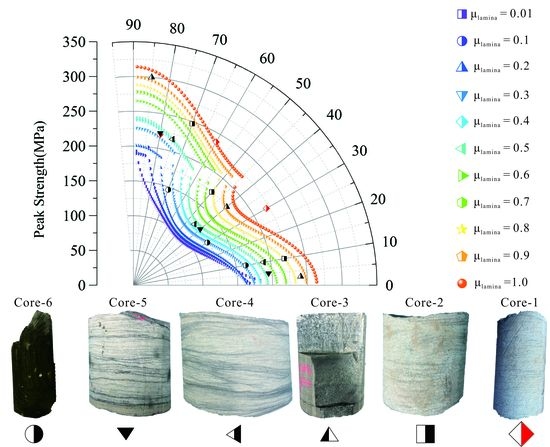Finite Element Simulation of Multi-Scale Bedding Fractures in Tight Sandstone Oil Reservoir
Abstract
:1. Introduction
2. Materials and Methods
2.1. Materials
2.2. Triaxial Compression Tests
2.3. Finite Element Simulation
3. Results
3.1. Stress Balance along the Lamina
3.2. The Failure Criterion of Bedding Fractures
3.3. Index of Bedding Fractures
4. Discussion
4.1. Comparisons of Different Failure Criteria For Bedding Fractures
4.2. Lamina Friction Coefficients of Different Lamina Lithofacies
4.3. Stress Distribution in the Laminated Rock
4.4. Distribution of the Regional Bedding Fractures
5. Conclusions
Author Contributions
Funding
Acknowledgments
Conflicts of Interest
Nomenclature
| σ1 | the maximum principal stress |
| σ3 | the minimum principal stress |
| θ | the lamina angle |
| μlamina | the lamina friction coefficient |
| Clamina | the lamina cohesion |
| f | the friction force between the lamina surface and surrounding rock |
| φ | the internal friction angle |
| S0 | the cohesion of laminated rocks |
| k and n | the elastic constants of laminated rocks |
| β | the acute angle between the direction of maximum principal stress and the discontinuity |
| Cj | the lamina cohesion in the Jaeger criterion |
| φj | the internal friction angle in the Jaeger criterion |
| T0 | the tensile strength |
| fLF | the fracture index of lamina induced fractures |
| T0-lamina | the tensile strength of laminated sandstone |
| μ | the coefficient of internal friction |
| the maximum normal stress satisfied the critical rupture condition |
Appendix A
References
- Cheng, Y.; Lu, Y.; Ge, Z.; Cheng, L.; Zheng, J.; Zhang, W. Experimental study on crack propagation control and mechanism analysis of directional hydraulic fracturing. Fuel 2018, 218, 316–324. [Google Scholar] [CrossRef]
- Desai, C.S.; Zaman, M.M.; Lightner, J.G.; Siriwardane, H.J. Thin-layer element for interfaces and joints. Int. J. Numer. Anal. Methods Geomech. 1984, 8, 19–43. [Google Scholar] [CrossRef]
- Hu, S.-C.; Tan, Y.-L.; Zhou, H.; Guo, W.-Y.; Hu, D.-W.; Meng, F.-Z.; Liu, Z.-G. Impact of Bedding Planes on Mechanical Properties of Sandstone. Rock Mech. Rock Eng. 2017, 50, 2243–2251. [Google Scholar] [CrossRef]
- Ma, L.-J.; Liu, X.-Y.; Wang, M.-Y.; Xu, H.-F.; Hua, R.-P.; Fan, P.-X.; Jiang, S.-R.; Wang, G.-A.; Yi, Q.-K. Experimental investigation of the mechanical properties of rock salt under triaxial cyclic loading. Int. J. Rock Mech. Min. Sci. 2013, 62, 34–41. [Google Scholar] [CrossRef]
- Sampath, K.H.S.M.; Perera, M.S.A.; Elsworth, D.; Ranjith, P.G.; Matthai, S.K.; Rathnaweera, T. Experimental Investigation on the Mechanical Behavior of Victorian Brown Coal under Brine Saturation. Energy Fuels 2018, 32, 5799–5811. [Google Scholar] [CrossRef]
- Tien, Y.M.; Kuo, M.C. A failure criterion for transversely isotropic rocks. Int. J. Rock Mech. Min. Sci. 2001, 38, 399–412. [Google Scholar] [CrossRef]
- Vervoort, A.; Min, K.-B.; Konietzky, H.; Cho, J.-W.; Debecker, B.; Dinh, Q.-D.; Frühwirt, T.; Tavallali, A. Failure of transversely isotropic rock under Brazilian test conditions. Int. J. Rock Mech. Min. Sci. 2014, 70, 343–352. [Google Scholar] [CrossRef]
- Wu, J.-H.; Ohnishi, Y.; Nishiyama, S. Simulation of the mechanical behavior of inclined jointed rock masses during tunnel construction using Discontinuous Deformation Analysis (DDA). Int. J. Rock Mech. Min. Sci. 2004, 41, 731–743. [Google Scholar] [CrossRef]
- Zhang, Z.-H.; Deng, J.-H.; Zhu, J.-B.; Li, L.-R. An Experimental Investigation of the Failure Mechanisms of Jointed and Intact Marble under Compression Based on Quantitative Analysis of Acoustic Emission Waveforms. Rock Mech. Rock Eng. 2018, 51, 2299–2307. [Google Scholar] [CrossRef]
- Zhou, Y.; Wu, S.; Li, Z.; Zhu, R.; Xie, S.; Jing, C.; Lei, L. Multifractal Study of Three-Dimensional Pore Structure of Sand-Conglomerate Reservoir Based on CT Images. Energy Fuels 2018, 32, 4797–4807. [Google Scholar] [CrossRef]
- Cilona, A.; Aydin, A.; Likerman, J.; Parker, B.; Cherry, J. Structural and statistical characterization of joints and multi-scale faults in an alternating sandstone and shale turbidite sequence at the Santa Susana Field Laboratory: Implications for their effects on groundwater flow and contaminant transport. J. Struct. Geol. 2016, 85, 95–114. [Google Scholar] [CrossRef] [Green Version]
- Ishii, E. The role of bedding in the evolution of meso- and microstructural fabrics in fault zones. J. Struct. Geol. 2016, 89, 130–143. [Google Scholar] [CrossRef]
- Zhang, Y.; Zhang, Z.; Sarmadivaleh, M.; Lebedev, M.; Barifcani, A.; Yu, H.; Iglauer, S. Micro-scale fracturing mechanisms in coal induced by adsorption of supercritical CO 2. Int. J. Coal Geol. 2017, 175, 40–50. [Google Scholar] [CrossRef] [Green Version]
- Li, Y.; Song, Y.; Jiang, Z.; Yin, L.; Chen, M.; Liu, D. Major factors controlling lamina induced fractures in the Upper Triassic Yanchang formation tight oil reservoir, Ordos basin, China. J. Asian Earth Sci. 2018, 166, 107–119. [Google Scholar] [CrossRef]
- Espinoza, D.N.; Shovkun, I.; Makni, O.; Lenoir, N. Natural and induced fractures in coal cores imaged through X-ray computed microtomography—Impact on desorption time. Int. J. Coal Geol. 2016, 154–155, 165–175. [Google Scholar] [CrossRef]
- Li, L.; Sheng, J.J.; Su, Y.; Zhan, S. Further Investigation of Effects of Injection Pressure and Imbibition Water on CO2 Huff-n-Puff Performance in Liquid-Rich Shale Reservoirs. Energy Fuels 2018, 32, 5789–5798. [Google Scholar] [CrossRef]
- Li, Y.; Song, Y.; Jiang, Z.; Yin, L.; Luo, Q.; Ge, Y.; Liu, D. Two episodes of structural fractures: Numerical simulation of Yanchang Oilfield in the Ordos basin, northern China. Mar. Pet. Geol. 2018, 97, 223–240. [Google Scholar] [CrossRef]
- Liang, S.; Elsworth, D.; Li, X.; Fu, X.; Sun, B.; Yao, Q. Key strata characteristics controlling the integrity of deep wells in longwall mining areas. Int. J. Coal Geol. 2017, 172, 31–42. [Google Scholar] [CrossRef]
- Liu, J.; Ding, W.; Wang, R.; Yin, S.; Yang, H.; Gu, Y. Simulation of paleotectonic stress fields and quantitative prediction of multi-period fractures in shale reservoirs: A case study of the Niutitang Formation in the Lower Cambrian in the Cen’gong block, South China. Mar. Pet. Geol. 2017, 84, 289–310. [Google Scholar] [CrossRef]
- Liu, J.; Ding, W.; Yang, H.; Wang, R.; Yin, S.; Li, A.; Fu, F. 3D geomechanical modeling and numerical simulation of in-situ stress fields in shale reservoirs: A case study of the lower Cambrian Niutitang formation in the Cen’gong block, South China. Tectonophysics 2017, 712–713, 663–683. [Google Scholar] [CrossRef]
- Weniger, S.; Weniger, P.; Littke, R. Characterizing coal cleats from optical measurements for CBM evaluation. Int. J. Coal Geol. 2016, 154–155, 176–192. [Google Scholar] [CrossRef]
- Widera, M. Lignite cleat studies from the first Middle-Polish (first Lusatian) lignite seam in central Poland. Int. J. Coal Geol. 2014, 131, 227–238. [Google Scholar] [CrossRef]
- Zeng, L.; Li, X. Fractures in sandstone reservoirs with ultra-low permeability: A case study of the Upper Triassic Yanchang Formation in the Ordos Basin, China. AAPG Bull. 2009, 93, 461–477. [Google Scholar]
- Małkowski, P.; Ostrowski, Ł.; Brodny, J. Analysis of Young’s modulus for Carboniferous sedimentary rocks and its relationship with uniaxial compressive strength using different methods of modulus determination. J. Sustain. Min. 2018, 17, 145–157. [Google Scholar] [CrossRef]
- Cai, Y.; Liu, D.; Mathews, J.P.; Pan, Z.; Elsworth, D.; Yao, Y.; Li, J.; Guo, X. Permeability evolution in fractured coal—Combining triaxial confinement with X-ray computed tomography, acoustic emission and ultrasonic techniques. Int. J. Coal Geol. 2014, 122, 91–104. [Google Scholar] [CrossRef]
- Kędzior, S.; Dreger, M. Methane occurrence, emissions and hazards in the Upper Silesian Coal Basin, Poland. Int. J. Coal Geol. 2019, 211, 103226. [Google Scholar] [CrossRef]
- Tutak, M.; Brodny, J. Forecasting Methane Emissions from Hard Coal Mines Including the Methane Drainage Process. Energies 2019, 12, 3840. [Google Scholar] [CrossRef] [Green Version]
- Ardakani, O.H.; Sanei, H.; Ghanizadeh, A.; McMechan, M.; Ferri, F.; Clarkson, C.R. Hydrocarbon potential and reservoir characteristics of Lower Cretaceous Garbutt Formation, Liard Basin Canada. Fuel 2017, 209, 274–289. [Google Scholar] [CrossRef]
- Fan, D.; Ettehadtavakkol, A. Semi-analytical modeling of shale gas flow through fractal induced fracture networks with microseismic data. Fuel 2017, 193, 444–459. [Google Scholar] [CrossRef]
- Gong, J.; Rossen, W.R. Characteristic fracture spacing in primary and secondary recovery for naturally fractured reservoirs. Fuel 2018, 223, 470–485. [Google Scholar] [CrossRef]
- Lyu, W.; Zeng, L.; Zhang, B.; Miao, F.; Lyu, P.; Dong, S. Influence of natural fractures on gas accumulation in the Upper Triassic tight gas sandstones in the northwestern Sichuan Basin, China. Mar. Pet. Geol. 2017, 83, 60–72. [Google Scholar] [CrossRef]
- Mehana, M.; Al Salman, M.; Fahes, M. Impact of Salinity and Mineralogy on Slick Water Spontaneous Imbibition and Formation Strength in Shale. Energy Fuels 2018, 32, 5725–5735. [Google Scholar] [CrossRef]
- Zeng, L.; Tang, X.; Wang, T.; Gong, L. The influence of fracture cements in tight Paleogene saline lacustrine carbonate reservoirs, western Qaidam Basin, northwest ChinaGeologic Notes. AAPG Bull. 2012, 96, 2003–2017. [Google Scholar] [CrossRef]
- Parvizi, H.; Rezaei-Gomari, S.; Nabhani, F. Robust and Flexible Hydrocarbon Production Forecasting Considering the Heterogeneity Impact for Hydraulically Fractured Wells. Energy Fuels 2017, 31, 8481–8488. [Google Scholar] [CrossRef] [Green Version]
- Brodny, J.; Tutak, M. Exposure to Harmful Dusts on Fully Powered Longwall Coal Mines in Poland. Int. J. Environ. Res. Public Health 2018, 15, 3. [Google Scholar] [CrossRef] [Green Version]
- Ostojic, J.; Rezaee, R.; Bahrami, H. Production performance of hydraulic fractures in tight gas sands, a numerical simulation approach. J. Pet. Sci. Eng. 2012, 88–89, 75–81. [Google Scholar] [CrossRef]
- Tokhmchi, B.; Memarian, H.; Rezaee, M.R. Estimation of the fracture density in fractured zones using petrophysical logs. J. Pet. Sci. Eng. 2010, 72, 206–213. [Google Scholar] [CrossRef]
- Tutak, M.; Brodny, J. Predicting Methane Concentration in Longwall Regions Using Artificial Neural Networks. Int. J. Environ. Res. Public Health 2019, 16, 2. [Google Scholar] [CrossRef] [Green Version]
- Miller, P.; Dasgupta, S.; Shelander, D. Seismic imaging of migration pathways by advanced attribute analysis, Alaminos Canyon 21, Gulf of Mexico. Mar. Pet. Geol. 2012, 34, 111–118. [Google Scholar] [CrossRef]
- Maxwell, S.C.; Waltman, C.; Warpinski, N.R.; Mayerhofer, M.J.; Boroumand, N. Imaging Seismic Deformation Induced by Hydraulic Fracture Complexity. SPE Reserv. Eval. Eng. 2009, 12, 48–52. [Google Scholar] [CrossRef] [Green Version]
- Ding, W.; Fan, T.; Yu, B.; Huang, X.; Liu, C. Ordovician carbonate reservoir fracture characteristics and fracture distribution forecasting in the Tazhong area of Tarim Basin, Northwest China. J. Pet. Sci. Eng. 2012, 86–87, 62–70. [Google Scholar] [CrossRef]
- Ju, W.; Sun, W. Tectonic fractures in the Lower Cretaceous Xiagou Formation of Qingxi Oilfield, Jiuxi Basin, NW China Part one: Characteristics and controlling factors. J. Pet. Sci. Eng. 2016, 146, 617–625. [Google Scholar] [CrossRef]
- Zeng, L.; Wang, H.; Gong, L.; Liu, B. Impacts of the tectonic stress field on natural gas migration and accumulation: A case study of the Kuqa Depression in the Tarim Basin, China. Mar. Pet. Geol. 2010, 27, 1616–1627. [Google Scholar] [CrossRef] [Green Version]
- Jaeger, J.C. Shear failure of anisotropic rocks. Geol. Mag. 1960, 97, 65–72. [Google Scholar] [CrossRef]
- Zhou, Y.; Feng, X.; Xu, D.; Chen, D.; Li, S. Experimental study of mechanical response of thin-bedded limestone under bending conditions. Rock Soil Mech. 2016, 37, 1895–1902. [Google Scholar]
- Zhou, Y.-Y.; Feng, X.-T.; Xu, D.-P.; Fan, Q.-X. Experimental Investigation of the Mechanical Behavior of Bedded Rocks and Its Implication for High Sidewall Caverns. Rock Mech. Rock Eng. 2016, 49, 3643–3669. [Google Scholar] [CrossRef]
- Zhou, Y.-Y.; Feng, X.-T.; Xu, D.-P.; Fan, Q.-X. An enhanced equivalent continuum model for layered rock mass incorporating bedding structure and stress dependence. Int. J. Rock Mech. Min. Sci. 2017, 97, 75–98. [Google Scholar] [CrossRef]
- Fries, T.-P.; Belytschko, T. The extended/generalized finite element method: An overview of the method and its applications. Int. J. Numer. Methods Eng. 2010. [Google Scholar] [CrossRef]
- Geuzaine, C.; Remacle, J.-F. Gmsh: A 3-D finite element mesh generator with built-in pre- and post-processing facilities. Int. J. Numer. Methods Eng. 2009, 79, 1309–1331. [Google Scholar] [CrossRef]
- Liu, G.R.; Dai, K.Y.; Nguyen, T.T. A Smoothed Finite Element Method for Mechanics Problems. Comput. Mech. 2006, 39, 859–877. [Google Scholar] [CrossRef]
- Roters, F.; Eisenlohr, P.; Hantcherli, L.; Tjahjanto, D.D.; Bieler, T.R.; Raabe, D. Overview of constitutive laws, kinematics, homogenization and multiscale methods in crystal plasticity finite-element modeling: Theory, experiments, applications. Acta Mater. 2010, 58, 1152–1211. [Google Scholar] [CrossRef]
- Stefanou, G. The stochastic finite element method: Past, present and future. Comput. Methods Appl. Mech. Eng. 2009, 198, 1031–1051. [Google Scholar] [CrossRef] [Green Version]
- Wang, H. Numerical modeling of non-planar hydraulic fracture propagation in brittle and ductile rocks using XFEM with cohesive zone method. J. Pet. Sci. Eng. 2015, 135, 127–140. [Google Scholar] [CrossRef]
- Wang, X.; Shi, F.; Liu, H.; Wu, H. Numerical simulation of hydraulic fracturing in orthotropic formation based on the extended finite element method. J. Nat. Gas Sci. Eng. 2016, 33, 56–69. [Google Scholar] [CrossRef]
- Newberry, N.R.; Nicoll, R.A. Comparison of the action of baclofen with gamma-aminobutyric acid on rat hippocampal pyramidal cells in vitro. J. Physiol. 1985, 360, 161–185. [Google Scholar] [CrossRef] [PubMed]
- Fan, X.; Gong, M.; Zhang, Q.; Wang, J.; Bai, L.; Chen, Y. Prediction of the horizontal stress of the tight sandstone formation in eastern Sulige of China. J. Pet. Sci. Eng. 2014, 113, 72–80. [Google Scholar] [CrossRef]
- Fang, Y.; den Hartog, S.A.M.; Elsworth, D.; Marone, C.; Cladouhos, T. Anomalous distribution of microearthquakes in the Newberry Geothermal Reservoir: Mechanisms and implications. Geothermics 2016, 63, 62–73. [Google Scholar] [CrossRef] [Green Version]
- Rust, A.C.; Cashman, K.V. Multiple origins of obsidian pyroclasts and implications for changes in the dynamics of the 1300 B.P. eruption of Newberry Volcano, USA. Bull. Volcanol. 2007, 69, 825–845. [Google Scholar] [CrossRef]
- Zhang, G.; Wang, L.; Wu, Y.; Li, Y.; Yu, S. Failure mechanism of bedded salt formations surrounding salt caverns for underground gas storage. Bull. Eng. Geol. Environ. 2017, 76, 1609–1625. [Google Scholar] [CrossRef]
- Hajiabdolmajid, V.; Kaiser, P.K.; Martin, C.D. Modelling brittle failure of rock. Int. J. Rock Mech. Min. Sci. 2002, 39, 731–741. [Google Scholar] [CrossRef]
- Jing, L.; Nordlund, E.; Stephansson, O. A 3-D constitutive model for rock joints with anisotropic friction and stress dependency in shear stiffness. Int. J. Rock Mech. Min. Sci. Geomech. Abstr. 1994, 31, 173–178. [Google Scholar] [CrossRef]
- Liu, J.; Ding, W.; Yang, H.; Jiu, K.; Wang, Z.; Li, A. Quantitative prediction of fractures using the finite element method: A case study of the lower Silurian Longmaxi Formation in northern Guizhou, South China. J. Asian Earth Sci. 2018, 154, 397–418. [Google Scholar] [CrossRef]
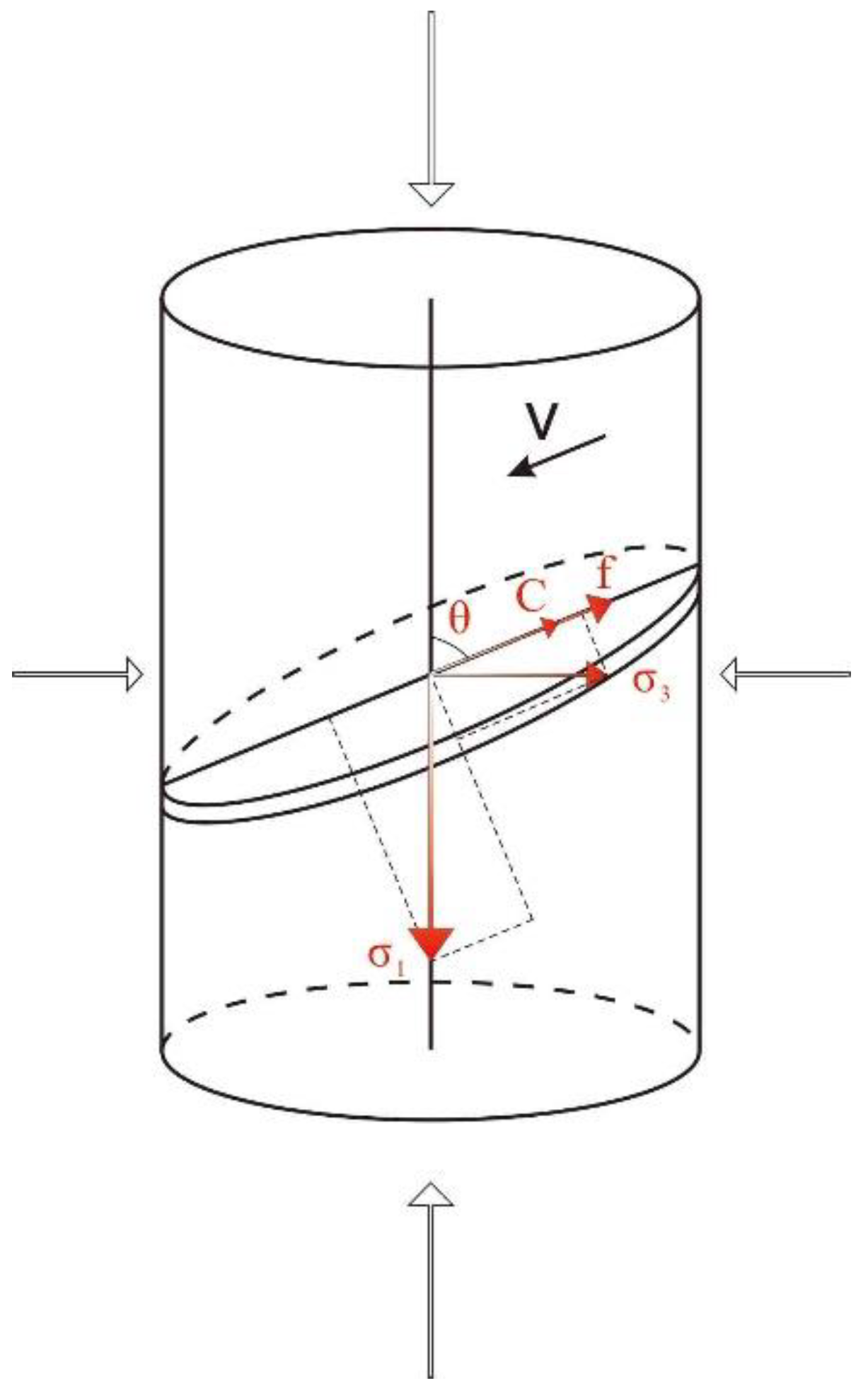
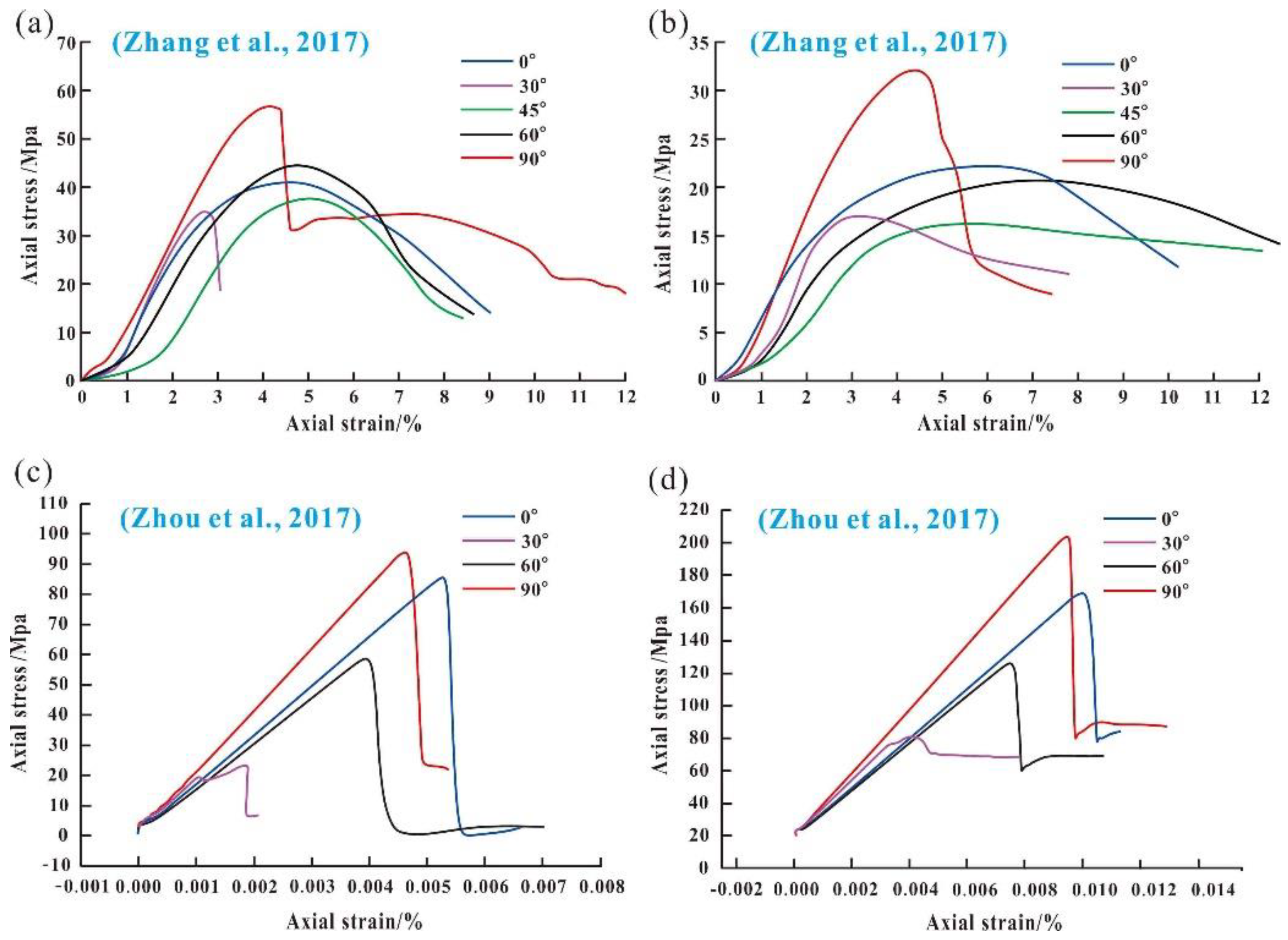
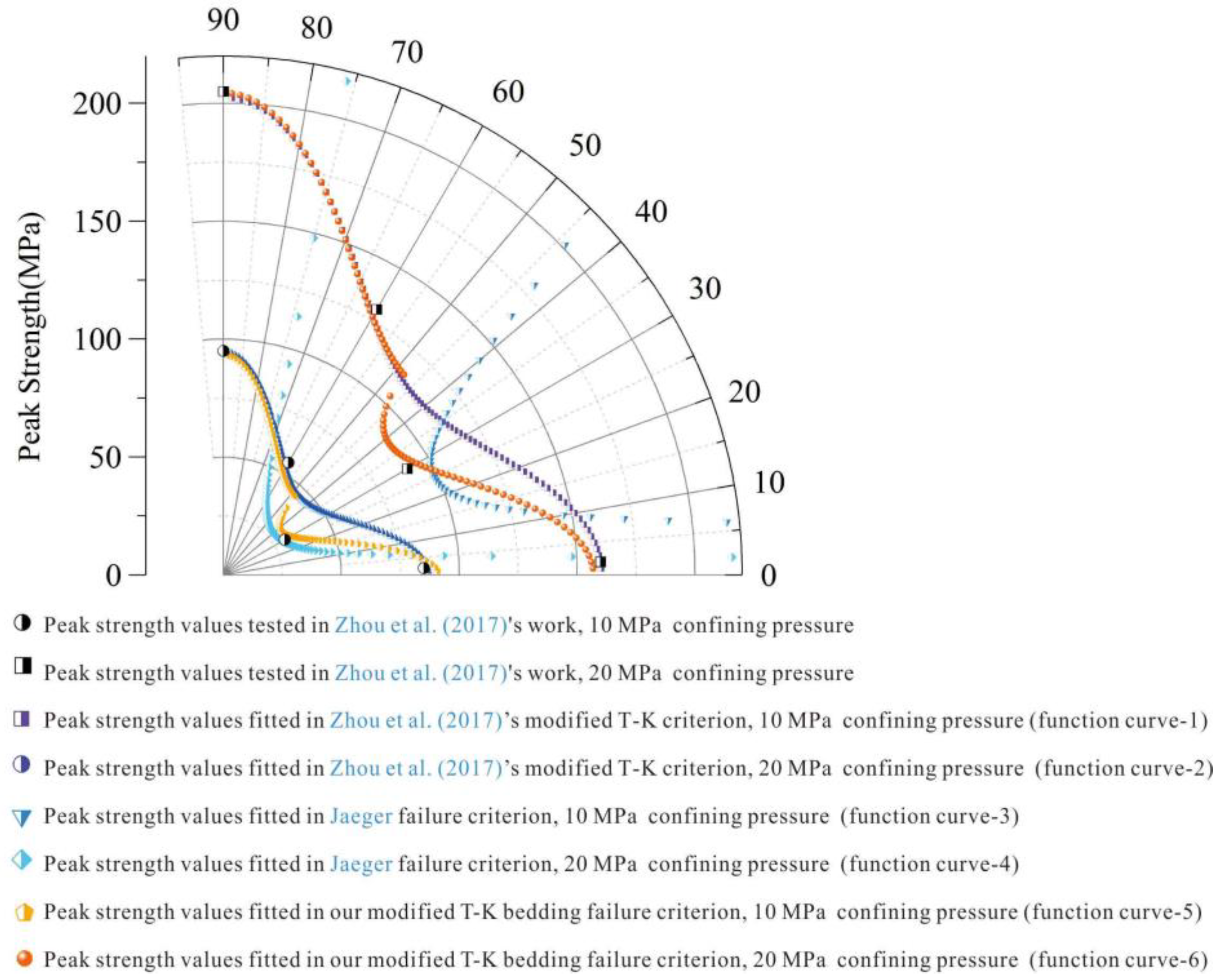
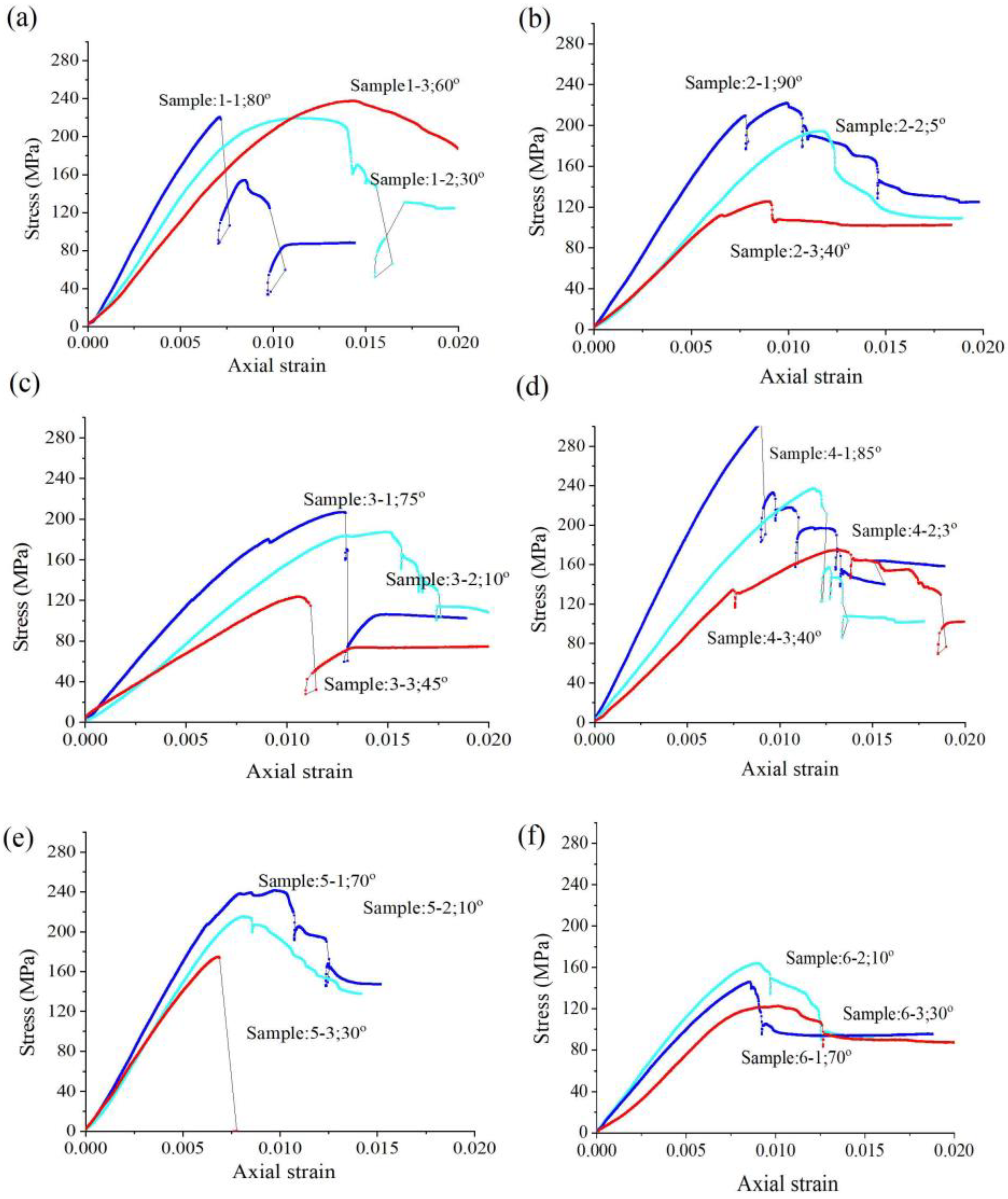

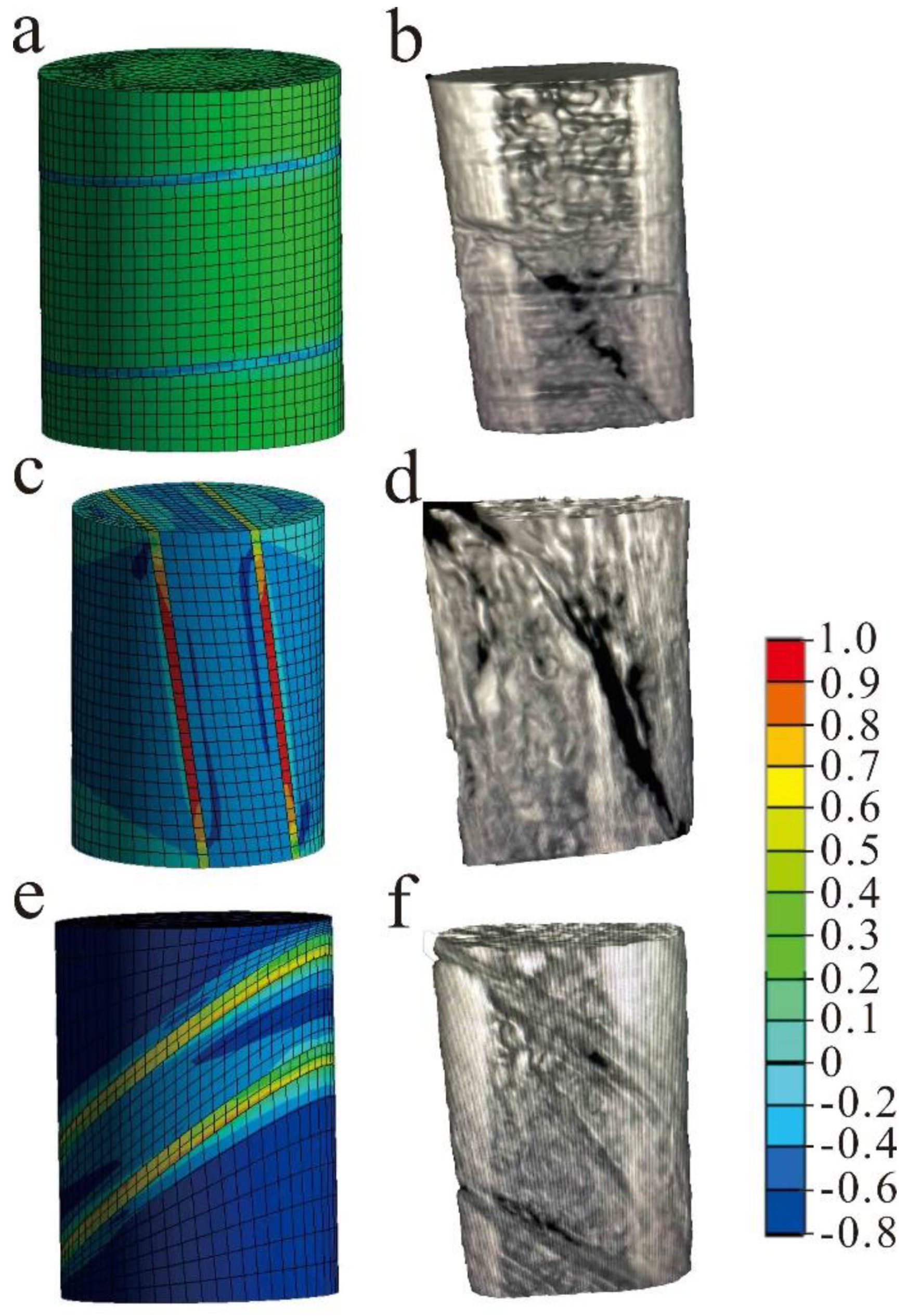
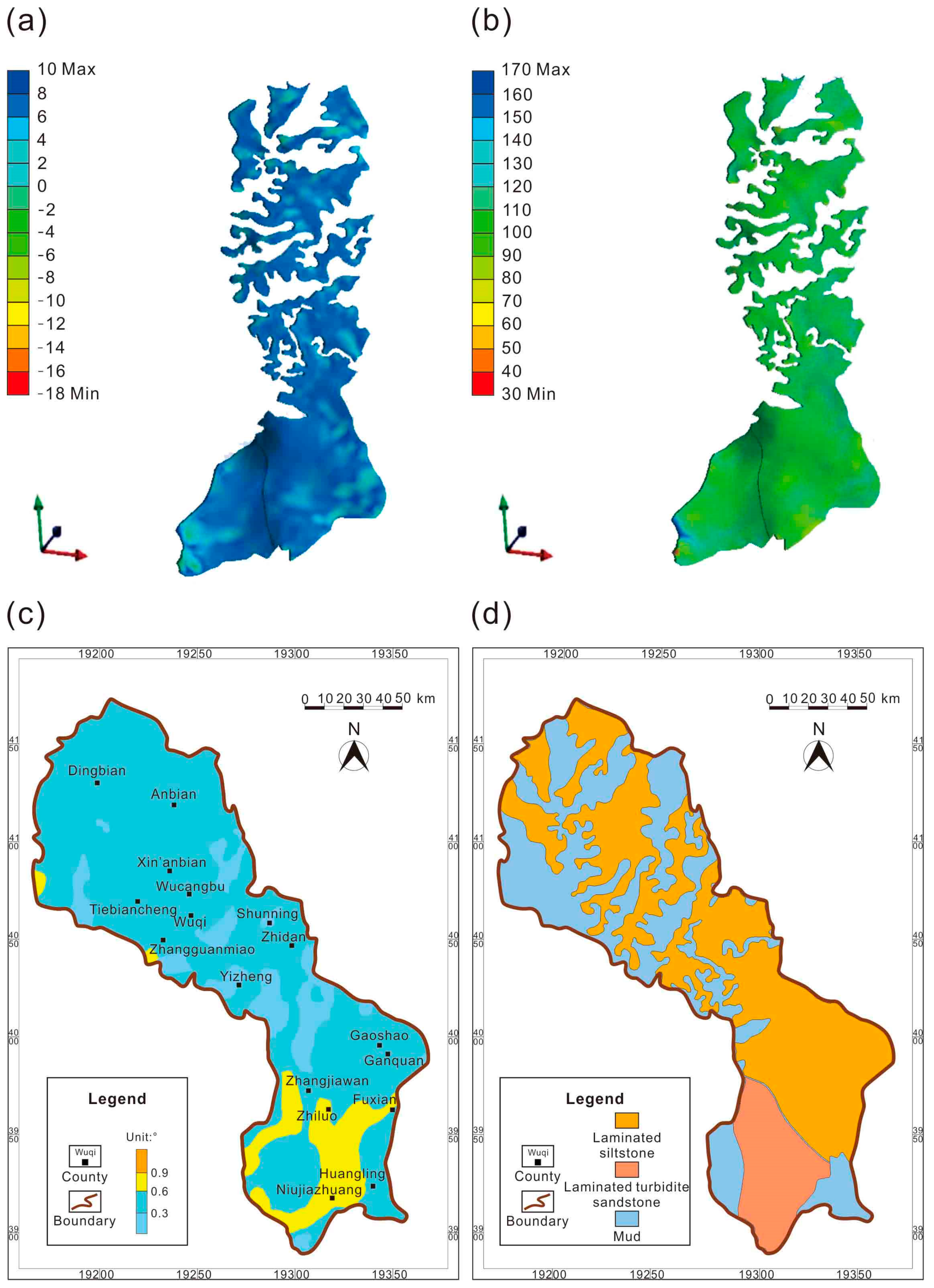
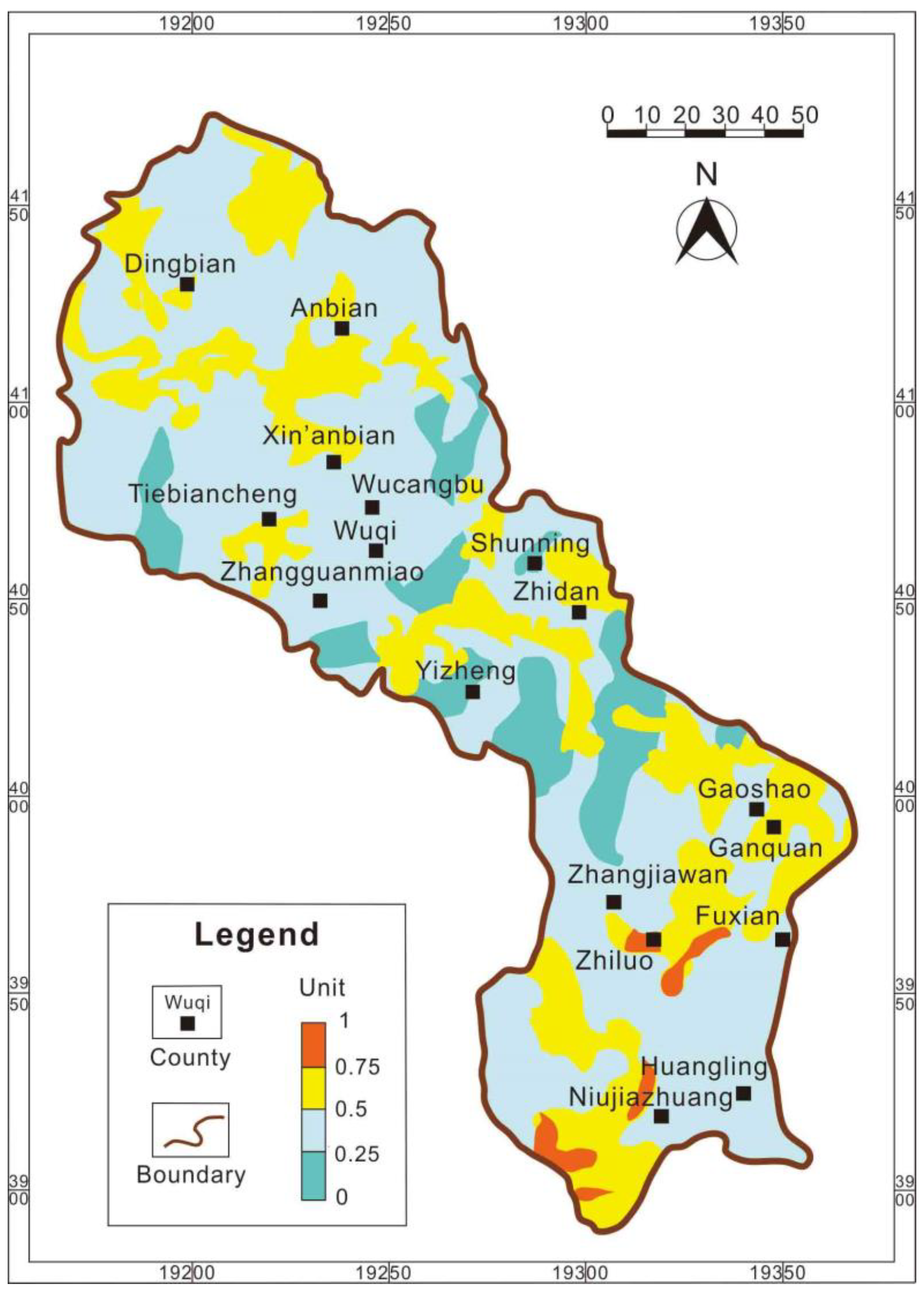
| Criterion | Literature Source |
|---|---|
| [44] | |
| [6] | |
| [47] |
| Criteria | n | k | Φ/° | μlamina | σ3/MPa | Clamina/MPa | S0/MPa | Cj */MPa | φj/° ** |
|---|---|---|---|---|---|---|---|---|---|
| The modified T–K criterion in this study | 8 | 0.5 | 63.5 | 0.1 | 10 | 20 | - | - | - |
| 3.3 | 1.1 | 63.5 | 0.9 | 20 | 20 | - | - | - | |
| Zhou et al. (2017)’s modified T–K criterion [47] | 11 | 3.3 | 63.5 | - | 10 | - | 11 | - | - |
| 2.2 | 1.3 | 63.5 | - | 20 | - | 8 | - | - | |
| Jaeger criterion [44] | - | - | - | - | 10 | - | - | 5 | 12 |
| - | - | - | - | 20 | - | - | 2 | 39.5 |
| Samples | Lamina Angle/° | Peak Strength/MPa | Confining Pressure/MPa |
|---|---|---|---|
| a-0 | 0 | 40.5 | 0 |
| a-30 | 30 | 35 | 0 |
| a-45 | 45 | 37.2 | 0 |
| a-60 | 60 | 44.1 | 0 |
| a-90 | 90 | 56.8 | 0 |
| b-0 | 0 | 22.2 | 0 |
| b-30 | 30 | 17.6 | 0 |
| b-45 | 45 | 17.1 | 0 |
| b-60 | 60 | 20.5 | 0 |
| b-90 | 90 | 32.3 | 0 |
| c-0 | 0 | 85.4 | 10 |
| c-30 | 30 | 23.2 | 10 |
| c-60 | 60 | 59.4 | 10 |
| c-90 | 90 | 94.1 | 10 |
| d-0 | 0 | 168 | 20 |
| d-30 | 30 | 80.4 | 20 |
| d-60 | 60 | 128 | 20 |
| d-90 | 90 | 205 | 20 |
| 1-1 | 80 | 221 | 20 |
| 1-2 | 30 | 220 | 20 |
| 1-3 | 60 | 239 | 20 |
| 2-1 | 90 | 222 | 20 |
| 2-2 | 5 | 195 | 20 |
| 2-3 | 40 | 124 | 20 |
| 3-1 | 75 | 208 | 20 |
| 3-2 | 10 | 189 | 20 |
| 3-3 | 45 | 122 | 20 |
| 4-1 | 85 | 300 | 20 |
| 4-2 | 3 | 234 | 20 |
| 4-3 | 40 | 175 | 20 |
| 5-1 | 70 | 241 | 20 |
| 5-2 | 10 | 218 | 20 |
| 5-3 | 30 | 173 | 20 |
| 6-1 | 70 | 146 | 20 |
| 6-2 | 10 | 162 | 20 |
| 6-3 | 30 | 121 | 20 |
© 2019 by the authors. Licensee MDPI, Basel, Switzerland. This article is an open access article distributed under the terms and conditions of the Creative Commons Attribution (CC BY) license (http://creativecommons.org/licenses/by/4.0/).
Share and Cite
Wang, Q.; Li, Y.; Yang, W.; Jiang, Z.; Song, Y.; Jiang, S.; Luo, Q.; Liu, D. Finite Element Simulation of Multi-Scale Bedding Fractures in Tight Sandstone Oil Reservoir. Energies 2020, 13, 131. https://doi.org/10.3390/en13010131
Wang Q, Li Y, Yang W, Jiang Z, Song Y, Jiang S, Luo Q, Liu D. Finite Element Simulation of Multi-Scale Bedding Fractures in Tight Sandstone Oil Reservoir. Energies. 2020; 13(1):131. https://doi.org/10.3390/en13010131
Chicago/Turabian StyleWang, Qianyou, Yaohua Li, Wei Yang, Zhenxue Jiang, Yan Song, Shu Jiang, Qun Luo, and Dan Liu. 2020. "Finite Element Simulation of Multi-Scale Bedding Fractures in Tight Sandstone Oil Reservoir" Energies 13, no. 1: 131. https://doi.org/10.3390/en13010131




